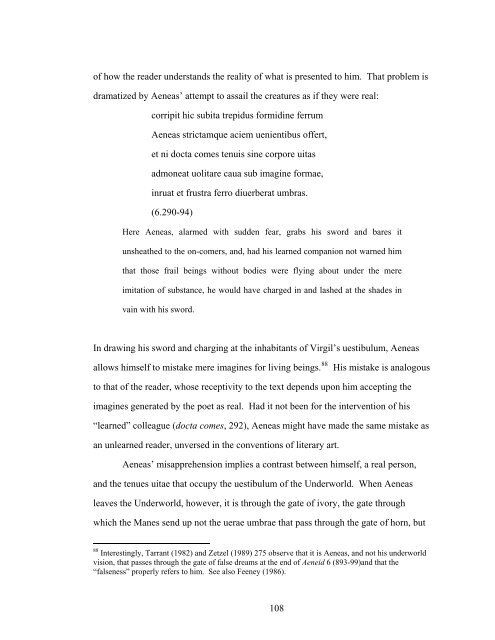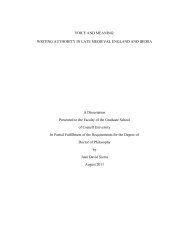Dissertation FINAL2.pdf - Cornell University
Dissertation FINAL2.pdf - Cornell University
Dissertation FINAL2.pdf - Cornell University
You also want an ePaper? Increase the reach of your titles
YUMPU automatically turns print PDFs into web optimized ePapers that Google loves.
of how the reader understands the reality of what is presented to him. That problem is<br />
dramatized by Aeneas’ attempt to assail the creatures as if they were real:<br />
corripit hic subita trepidus formidine ferrum<br />
Aeneas strictamque aciem uenientibus offert,<br />
et ni docta comes tenuis sine corpore uitas<br />
admoneat uolitare caua sub imagine formae,<br />
inruat et frustra ferro diuerberat umbras.<br />
(6.290-94)<br />
Here Aeneas, alarmed with sudden fear, grabs his sword and bares it<br />
unsheathed to the on-comers, and, had his learned companion not warned him<br />
that those frail beings without bodies were flying about under the mere<br />
imitation of substance, he would have charged in and lashed at the shades in<br />
vain with his sword.<br />
In drawing his sword and charging at the inhabitants of Virgil’s uestibulum, Aeneas<br />
allows himself to mistake mere imagines for living beings. 88<br />
His mistake is analogous<br />
to that of the reader, whose receptivity to the text depends upon him accepting the<br />
imagines generated by the poet as real. Had it not been for the intervention of his<br />
“learned” colleague (docta comes, 292), Aeneas might have made the same mistake as<br />
an unlearned reader, unversed in the conventions of literary art.<br />
Aeneas’ misapprehension implies a contrast between himself, a real person,<br />
and the tenues uitae that occupy the uestibulum of the Underworld. When Aeneas<br />
leaves the Underworld, however, it is through the gate of ivory, the gate through<br />
which the Manes send up not the uerae umbrae that pass through the gate of horn, but<br />
88 Interestingly, Tarrant (1982) and Zetzel (1989) 275 observe that it is Aeneas, and not his underworld<br />
vision, that passes through the gate of false dreams at the end of Aeneid 6 (893-99)and that the<br />
“falseness” properly refers to him. See also Feeney (1986).<br />
108
















